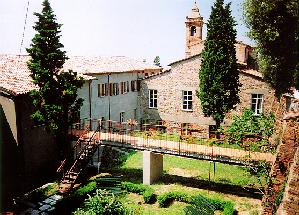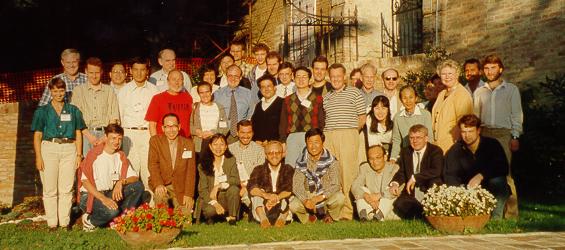The Fifth Inforum World Conference at Bertinoro, Italy
The fifth conference was held in Bertinoro, Italy, from September 15 to September 19, 1997. The conference was held in the Ravelin, pictured below, in the sede didattica.

Here is a brief summary of the papers and events of the conference:
- Monday, September 15
- On Monday morning we arrived, huffing and puffing after a walk up the hill to the Sede Didattica. The first course of business was a review of the activities of each of the groups over the past year. The German group has formed a new company, called GWS. The Russians were happy to tell us that their team had been enlarged, now with 6 people. Juan Carlos, of Fundacion Tomillo, had plenty of news on the many activities of their group, including a project on the impact of ports, and of Madrid infrastructure. Dirk related the joint cooperation of the Germans, the Chinese and the Uno group in Japan on a study of energy and trade, using models constructed in a framework called "QuickDyme". We were honored by the presence of some new partners from Hungary, who seemed eager to learn about Inforum activities.
- After coffee break, Toshiaki Hasegawa described the new Leontief Library housed in Chuo University, which contains books, notes and letters acquired from Wassily Leontief. Leontief has been invited to Chuo in the Fall to receive an honorary degree. Maurizio re-emphasized the need to get status reports and model descriptions from each of the Inforum partners, to use in a book describing the various models. Clopper Almon described and gave a demonstration of his new version of G for Windows 95, called G7. Douglas Meade gave an update on new features of Interdyme 2.3, as well as the DOS version of G, and the Compare program. Georg Ewerhart, Andreas Huerkamp and Frank Hohnmann demonstrated and described the user interface for the German model, built in Delphi, called IMAGINE. That evening we explored Bertinoro, and were treated to typical specialties from the Romagna area, along with excellent local wine and grappa, at the Osteria Serafina.
- Tuesday, September 16
- The two areas of focus for the morning session were environmental issues and foreign trade. Bernd Meyer presented a study entitled "Eco taxes, growth and structural change in the German economy", which compared the impacts of using tradeable permits versus taxes to reduce emissions. Christian Lutz presented results from his dissertation work on "Economic and environmental effects of advanced pollution abatement", and described techniques for forecasting emissions within the framework of Panta Rhei, an expanded version of the INFORGE model. Doug Nyhus gave a review of the Bilateral Trade Model, focussing on some of the patterns of investment in different countries, and how they affect trade patterns. The morning session drew to a close with Michal Przybylinski presenting "Foreign trade equations in the IMPEC model".
- The afternoon focus was on policy analysis, and we heard Elena Alonso present Tomillo's work on "The impact of the single currency in the Spanish economy". Maurizio presented a simulation study on the effects of a government expenditure reduction, within the context of the Italian INTIMO model.
- That evening we were treated to a fabulous cello and classical guitar duet, in the Hall of Frescoes, within the fortress tower. As we emerged on the landing of the tower to witness the sunset, we observed a total eclipse of the moon. The evening was topped off by dinner at La Grotta.
- Wednesday, September 17
- The first part of Wednesday morning was a focus on China, with a presentation by Mike Fields on the impact of statistical reform on the Mudan model. Qisheng Yu gave an account of the current structure of the Mudan model, focusing particularly on PADS consumption functions, and investment and productivity equations. In the next session on productivity and investment, Masayo Sato related the beginning work on her study to isolate developing and declining industries in Japan, and Toshiaki Hasegawa related further progress on the Japanese investment equations. Douglas Meade related work on the new IDLIFT model of the U.S., focusing on the relationship between capital and labor productivity, and a model relating price change to capacity utilization.
- After lunch, we set off for a tour to San Marino. Miraculously, we all made it back to the bus on time, and nobody was lost. Returning to Bertinoro, we had another five star supper at the Osteria Altopalato.
- Thursday, September 18
- Josef Richter opened up this session with "Reflections on Inforum modeling in a changing statistical environment," particularly describing how changes in the 1993 SNA and the European system will influence the development of economic statistics. Samuel Guillet reported further progress on the SWIMM model, in relation to new national accounts data. Gerd Ahlert from Germany presented a unique project on integrating sports into the German input-output table and into the INFORGE model. This was followed by a joint presentation by Boris Kusnetsov and Gosha Serebryakov on developments in Russia in the 1990s, and particular difficulties in modeling the unique current experiences of this troubled country. The morning session closed with Clopper Almon presenting the DUNA model of Hungary, with comments by Tamas Revesz.
- The afternoon was dedicated to a forum on global environmental modeling by Bernd Meyer, Wang YingChu and Dirk Vanwynsberghe. Bernd described work he has done with Uno's group on a model called COMPASS, a multi-country linked model studying trade and energy use. Wang and Dirk described the QuickDyme system which was used to construct these country models. The evening discussion was devoted to the future plans of the Inforum group. That evening's dinner at Il Gatto e la Volpe was joined by one of the newest members of the Inforum group, Oliver Meade.
- Friday, September 19
- The main focus of the Friday session was on experiences in estimating PADS (Perhaps Adequate Demand System) consumption equations. Mariusz Plich described the PCE equations he has recently estimated for the Polish IMPEC model. Takeshi Imagawa told us the progress that he and Laurent Haag have made on estimating the time series consumption equations for Japan. They will undertake the cross-sectional estimates using an extremely rich data set when they return to Japan. Rossella Bardazzi and Marco Barnabani completed this session with a report on the conclusion of the consumption study that they had initiated and talked about at the last conference.
- Next we turned away from the topic of consumption equations to hear a report by Soo Hee Lee on a detailed steel model for Korea, and the results of a study he had done with Doug Nyhus on projecting demand for various types of steel. Finally, the conference closed with a loud and clear report by Pan ShengChu on export and import data and equations for China. The afternoon continued with a computer lab hosted by Clopper in the fortress tower.
- That evening our whole group was granted a meeting with the mayor of the nearby town of Forli, and tour of some of the city center. This was followed by dinner at the Hotel Citta. Since economists must be able to tell a good lie, Maurizio gave a gift of a four-foot tall Pinocchio to Juan Carlos Collardo, who will host the Sixth conference next year.
On Saturday, those who remained enjoyed each other's company on a trip to Ravenna, a very old city important in the last stages of the Roman Empire. On the trip to Ravenna, our guide was Clopper, who gave a well-informed history of the area. Our guide in Ravenna was superb, and even Oliver enjoyed studying the beautiful mosaics in the churches. That evening, a tired group gathered at the Osteria dei Brutti, for a birthday celebration for Doug Meade and Rossella Bardazzi. There we said our goodbyes, as we were all leaving at different times the next morning.


A picture of (almost!) the whole group, after a particularly hard session.
